This week in Singapore marks the first Asian Siggraph. More than 3,200 artists, researchers, developers, gaming experts, filmmakers, as well as academics gathered over four days to discover new techniques, technology and approaches in the graphics. In all, a total of 49 countries were represented in an array of amazing animation and breakthrough ideas presented at the show.
One of the concerns of Siggraph in expanding to Asia was to make sure that the quality of the Asia event was on par with the traditional American event. From the papers we have managed to attend the quality is absolutely on par with what one would expect from Siggraph. We spoke to Pixar’s Tony Apodaca who described Siggraph Asia as being Siggraph (USA) ten years ago. Not only are the papers of a significant quality but the Siggraph Asia still hosts an Electronic theatre which had a great set of entries this year.
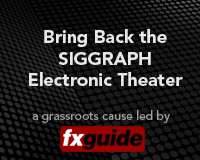
Note: if you’d like to see the Electronic theatre return to Siggraph USA in New Orleans sign our Petition. We love Siggraph but the one thing that was ‘missing in action’ this past year in LA was the Electronic Theater — always a highlight of the show. So to show our support for ACM SIGGRAPH , we’ve started a grassroots online petition to let the SIGGRAPH organizers know how much we and others missed the event. Please take a moment to sign the online petition and help sway the organizers to bring it back to New Orleans. And while you’re at it, reserve August 3rd through the 7th on your calendar for SIGGRAPH 2009.
Day One:
The conference
Autodesk training Seminar
I started this years Siggraph Asia with a panel discussion on Education – which included some great people such as TJ Galda (EA) , Ian Cope ( RSP) , Prashant Buyyala (R&H), Eric Riewer (Gobelins School) Laura Dohrmann (Nvida), Dr Kathy Blashki (AFTRS), hosted by David Della -Rocca (Autodesk) and with special keynote from SPI’s Senior VP Barry S Weiss.
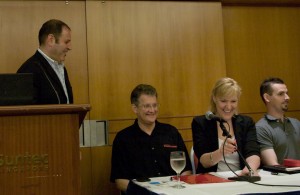
All the panel had great points, Barry Weiss’s keynote however contained one of the funnier gems. He showed a video SPI has been making to explain what they want to see on show reels. Amongst great points such as
– keep it short – and the most impressive stuff in the first 45 sec
– make the music not be heavy metal
– don’t include drawing (they assume you have those skills – valuable as they are)
– show delivered quality animation and story telling
But there was one additional gem: Don’t spend hours and days on the packaging and your personal logo design, in the words of the one of the SPI reviewers: “really complex and fancy packaging makes us ask – How come you have so much time on your hands – it pretty much says you are unemployed !”
Following the Education panel we had lunch with the management and senior members of the ACM and Siggraph. It was during this lunch that the issue of the ET came up, and we were told that ACM listens to members so if we can show support for the ET, there is no reason why it cannot be brought back. Actually ACM CEO Dr. John White, who runs the organization above Siggraph itself, was unaware that the ET had been removed and commented that he himself had seen Luxo, Jr. at its original showing in the ET Siggraph Anaheim.
Amongst the positive discussion we learnt the one of the strengths of the ACM is that it allows Siggraph to retain funds at the Siggraph level of the ACM thereby allowing the organization to invest in things like Siggraph Asia. It also supports Siggraph running Siggraph Asia at a loss for the next few years as it builds a solid place in the graphics community. Interestingly, in talking to key exhibitors we found that while some came more to “test the waters” with smaller booths this year, Pixar commented that its initial impression was to return to next year’s Asian conference in Yokohama with a bigger booth and perhaps a recruiting program. The year after next, 2010 will be in Seoul Korea.
This years event was hit by triple punches of – the global financial crisis, the horrible Indian terrorist attacks, and the Bangkok airport incident – that being said, attendance was good and technical papers we attended in some cases were standing room only.
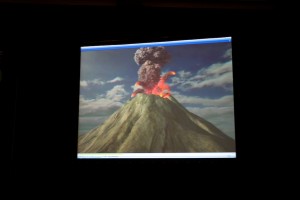
After the show closed on the first day most key people moved to the Autodesk user group. In the style of the much larger User Group in LA this year, there was a series of industry speakers and some great product demonstrations. If Siggraph is dominated by 3D graphics, then Autodesk dominates 3D applications. Highlights included Barry Weiss discussing iRobot and other SPI projects, Zap Anderson showing Blur’s cinematic using mental ray for Warhammer Age of Reckoning. The cinematic was rendered entirely with GI – sun and sky, unusual for animation of this type. url(http:// www.warhammer.com, web site). He also showed the MAX Fume plug in now rendering in Mental Ray.
One of several great presentations came from Autodesk Maya legend Duncan who showed Nparticles from Maya 2009 not using expressions. This built on the demo given at the USA Siggraph 08 user group but went further showing an entire volcano erupting – all in realtime.
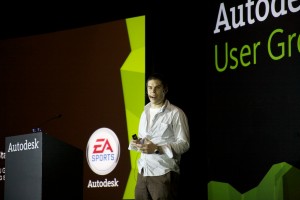
— TJ Galda from EA ( tjgalad.com )gave an entertaining demo showing the evolution of the FIFA franchise from : FIFA 1994 – 1999 – 2005 to 2009. For the first few years the screens and game play looked similar but just higher resolution, but at the end the once red vs blue icon sized players had become a massive closeup of individual real world FIFA stars with beautifully blended game play.
– Ian Cope of Rising Sun Pictures (RSP) showed 140,000 killer leaves eating human flesh. RSP most recently just wrapped on the feature “Australia”.
– Bollywood fully animated feature
Autodesk Party
And then it was time to party… and Autodesk did not disappoint. For more photos check out our flickr group .

Day Two:
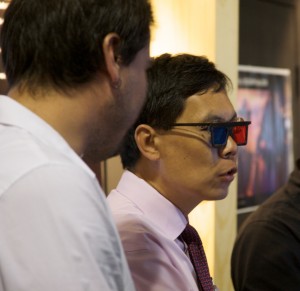
The official Opening Ceremony was on day two of the conference, presided over by the Minister, who the day before had also announced the opening of Mediaoplis – a major film investment centre for Singapore.
RAdm (NS) Lui Tuck Yew Senior Minister : Minister of Information, Communication and the Arts, opened Siggraph Asia, and spoke briefly about the governments commitment to R&D and the film industry in general. The centerpiece of this week’s announcement is a 19-hectare (ha) plot of land has been earmarked for the development of what shall be called Mediapolis.
When ready, it will be a hub that will house a media ecosystem comprising
– soundstages with green screens;
– digital production and broadcast facilities;
– interactive digital media (IDM) and R&D activities;
– computer-generated Imagery and visual effects; post-production,
– games and animation;
– industry-response digital media schools, business parks and work lofts
This is part of an estimated $500 Million to R&D in this area announced by the Government, The Minster explained that our industry is ” one of three key vertical pilars” of the current economic Plan. Mediapolis – will break ground on 1.2 Hectares for the first phase in 2009.
Papers
The backbone of any Siggraph are the technical papers. They represent the very finest academic rigors of excellence, or to speak plainly: really hard to get into. Siggraph Asia was no exception. The papers have been extremely comprehensive and every bit on par with Siggraph USA. Most people were perhaps expecting a far less impressive papers section to the first ever Asian Siggraph, but the papers were not only every bit as good as the USA normal standards, but very well attended. For example among many sessions fxguide attended, on day 2 we attended the afternoon session entitled : Fun With Single Images.
Here is a summary of that session:
Deep Photo: Model-Based Photograph Enhancement and Viewing
A novel method for browsing, enhancing, and manipulating outdoor photographs by combining them with existing geo-referenced digital terrain and urban models.
Johannes Kopf of Universität Konstanz led the papers of this session with the most brilliant paper on using geo-taging for picture grading: In summary with so much information and freely available information and geo terrain information on the Net, Kopf and the team (many from Microsoft) realized that once you took a photo with geo-tag information – such as a happy snap on an iphone, a program could be written that would use that information to provide a stunning array of options.
Firstly they showed finding the actual position, height and orientation of a photographer who took a snap of New York via geo-tag cross referencing and image matching from data off the net – then using the same information to build a Z depth map of the day snap and finally remove distance haze that otherwise made the image flat and uninteresting. They proceeded to then regrade the shot for any time of day – pointing out that professional photographers shoot most often at dawn or as dusk during magic hour while amateur photographers shoot in the middle of the day.
These regrades were then animated to a full timelapse with accurate shadows of an entire day in the life of NY – all from one happy snap. Sky could be replaced – building automatcially moved and match graded based on actual Z-depth all seamlessly and interactively. The paper then went on to show a portrait shot of a National Park – Geo tagged and then extended to a large Panorama – not only using the snap shot but then sampling color- light and textures from the original and applying them to Geo -taged 3D model publicly available models of the natural terrain.
The result on vertical image becomes an accurate horizontal wide angle shot including mountains and details never in the original shot but all seamlessly and professionally accurately added and extended. This was nothing short of breathtaking.
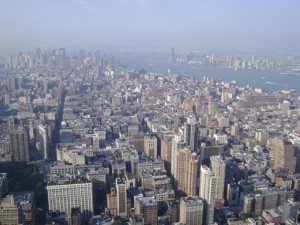

Animating Animal Motion From Still Images
A novel technique to infer and animate animal motions from a still image.
Xuemiao Xu, Liang Wan, Xiaopei Liu, Tien-Tsin Wong and Liansheng Wang from The Chinese University of Hong Kong then showed what is believed to be the first ever automatic nature animation obtained from a single image.
In nature is it easy to snap a shot of a herd or flock of birds. These shots are extremely common but the team noticed that in these single shots of flocks of say birds you have actually multiple samples of the natural cyclic nature of that species of birds flight or wing animation. literally each bird is doing a rhythmical repetitive movement – in this case flapping wing – but all out of sync.
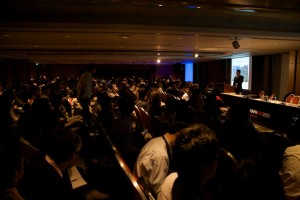
This gives the viewer multiple samples along the species ‘walk cycle” but of course in random order and without any naturally occurring interval. So it is a bit like random frames of a single bird in flight but all over the frame and out of sync and at random intervals. In their paper using both birds and a herd of elephants they showed a system that stabilized the bird snap shots, aligned them, worked out the correct order and then automatically morphed between frames to complete a complete cycle of their movement.
This was then put back into a photoshopped cleaned up version of the original frame and bingo – one snap shot of a single herd of elephants taken without any special lenses or considerations – produced a remarkably good animated herd of Elephants, all you needed to do was pick the speed you wanted them to charge off your image and exit frame. While the system is not perfect, it is remarkable and will no doubt open up more papers in this area.
Optimised Scale-and-Stretch for Image Resizing
Yu-Shuen Wang of theNational Cheng Kung University presented an image-resizing method that computes an optimal scaling transformation for each local region, such that the aspect ratios of the automatically detected prominent features are preserved.
Many of us have seen the new scene carving technology in CS4. This ability to intelligently resize an image without scaling key aspects – such as people – within the frame has often been compared to ‘magic’ but in reality the system has limits and can breakdown if the image has a large single object – such as a car vs lots of standing people with gaps between them. The teams paper interestingly points out that sometimes it is a good idea to scale the key elements in the image – say a long car – but that it need to be scaled uniformly – not just horizontally for example.
This sounds simple but visually this means if there is a house with a garden and you need the whole image narrower than say the width of the house, the image is scaled, morphed and rebuilt with the house smaller the garden still scene carved and the sky extended – all interactively and automatcially. In short it rebuilds the composition of the whole image extremely intelligently in much the same way a matte painter may rebuild a composition but it does this in realtime. It made scene carving which had seemed very clever on the day before Siggraph Asia – rather simplistic and ordinary by the end of afternoons session! In the Q&A session – The team admitted that he was already working on a moving video version that would do the same thing – but he added the problem was also much harder than with a single still.
Authors:
Yu-Shuen Wang
National Cheng Kung University
Chiew-Lan Tai
The Hong Kong University of Science and Technology
Olga Sorkine
New York University
Tong-Yee Lee
National Cheng Kung University
There were several other papers such as the Interactive Normal Reconstruction From a Single Image and a very clever way of Depicting Procedural Caustics in Single Images. All in all this session was inspiring and completely sold out, even though it was in the largest presentation room – combining three normal lecture rooms.
Electronic theatre
700 submissions from 44 countries : 29 made the Electronic Theatre. And as in years gone by in the USA the Thursday night award winners ET show was great fun with the audience really appreciating the effort and talent on display. For credit to the judges for producing an outstanding night, and congratulations to all those selected for the night.
Winners:
Best of Show Award: This Way Up, Smith & Foulkes, Nexus Productions Ltd, United Kingdom
Nexus Productions short animated caper is about a day in the life of A.T. Shank & Son Undertakers as they make their way cross country with just a coffin for company. The animation feature was not only entertaining, but beautifully animated.
Jury Award: KUDAN, Taku Kimura, Links DigiWorks Inc., Japan
This 3D computer-animated fantasy film by Japanese production house Links DigiWorks is about a man who is accidentally transformed into a Kudan. Kudan is a Japanese monster which has a human head but the body of a cow. It speaks a human language, predicts war or disaster and dies in three days. The jury was unanimous in their decision to award Kudan a Jury award for its exceptional graphics display. It was also nice to see a film with such strong Asian culture going so well and being received so well by the entire audience.
Jury Award: Oktapodi, Gobelins, l’école de l’image, France
Six third-year students from Gobelins, l’école de l’image in France, created a slapstick comedy about two octopuses as they help each other escape from the grasps of a stubborn Greek restaurant Chef. Oktapodi represented the best of all student works submitted to SIGGRAPH Asia and jury members picked the award not only for its narrative and entertainment value, but also to encourage students to produce similar high quality work. Gobelins now only does team animations to foster a professional collaborative experience.
Personal and crowd favorites from the fxguide “highly unscientific” exit poll.
• ETA Director: Henrik Bjerregaard Clausen watch it here
• Jungle Jail url(http://www.junglejail.com/junglejail.html Click here for the film)
• This Way Up url(http://www.nexusproductions.com/ click here navigate for directors Smith and Foulkes)
• Oktapodi url(http://www.oktapodi.com/ click here for the film web site)
• Blind Spot, a great french film completed in 2007
• AppleSeed – John Woo
• Tipping point Guinness
• BBC Iplayer Penguins
